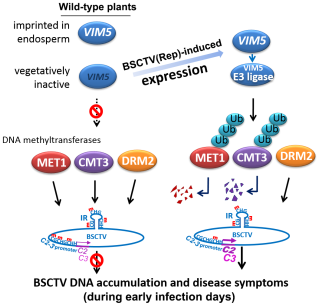Geminiviruses represent a large family of plant viruses with genomes comprising single-stranded circular DNAs and are a major threat to economically important crops such as maize, tomato and cassava. The plant hosts have developed antiviral defence systems such as RNA interference that ensures viral post-transcriptional gene silencing (PTGS) and small RNA-mediated DNA methylation that triggers transcriptional gene silencing (TGS) of the viral DNA. In an evolutionary arms race, geminiviruses have developed counter-defence systems to overcome both TGS and PTGS through multiple viral suppressors of silencing (VSRs). While the anti-silencing activity of VSRs are well described, such as C2 known to interfere with the host methyl cycling system, the molecular mechanisms allowing C2 to escape silencing at early stages of the viral infection remain enigmatic.
Recently, the group of Dr. Guo Hui-Shan in the State Key Laboratory of Plant Genomics, Institute of Microbiology, Chinese Academy of Sciences, used the geminivirus Beet Severe Curly Top Virus (BSCTV) as model to investigate the molecular mechanisms permitting early C2 expression. They unexpectedly found that activation of the C2 in transgenic Arabidopsis thaliana plants which carry C2/C3 promoter-containing viral DNA fragment is correlated with the aberrantly vegetative expression of VARIANT IN METHYLATION5 (VIM5), an endosperm imprinted gene. BSCTV infection of wild type Arabidopsis plants recapitulated the molecular pattern observed in the transgenic plants, They further demonstrated that VIM5 is a ubiquitin E3 ligase that directly targets the DNA methyltransferases MET1 and CMT3 for degradation by the ubiquitin-26S proteasome proteolytic pathway, leading to the early activation of C2 and C3 coupled with reduced CG and CHG symmetric methylation in the C2/C3 promoter and the onset of disease symptoms.
These findings reveal that a virus-activated host E3 ligase participates in posttranslational regulation of DNA methyltransferases to facilitate the expression of the early-class C2 and C3 genes of a plant-infecting DNA virus. In addition to providing a novel view on the geminivirus-plant interactions, this study also provides clues on VIM5 function in embryo development.
The Ph.D. student Zhong-Qi Chen as the first author and Dr. Guo Hui-Shan as the corresponding author. This work was supported by National Natural Science Foundation of China.
http://www.plantcell.org/content/early/2020/08/07/tpc.20.00249

Figure legend: BSCTV infection triggers the ectopic expression of the host endosperm-imprinted E3 ubiquitin ligase-encoding gene VIM5. VIM5 promotes 26S proteasomal degradation of the host DNA methyltransferases MET1 and CMT3, involved in the maintenance of CG and CHG methylation, respectively. VIM5 activity results in the hypomethylation and transcription of the geminiviral C2 and C3 genes, which encode a viral suppressor of silencing and a replication enhancer protein, respectively, that promote early viral accumulation
Contact:
Dr.GUO Huishan
State Key Laboratory of Plant Genomics(Co-established with Institute of Genetics and Developmental Biology, CAS),Chinese Academy of Sciences,100101,Beijing, China
E-mail: guohs@im.ac.cn
